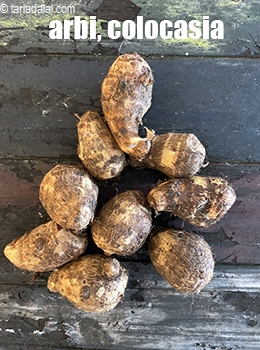
Also Known as
Taro, Dasheen, Kalo, Arbi, Arvi
What is colocasia, arbi, arbi root, taro?
Botanically speaking, the taro "root" is really a corm, a thickened, underground stem of certain plants, resembling bulbs. The smaller taro, or eddo, is popular in the Indian sub continent, Caribbean and West African cooking, but wearing gloves when peeling is a necessity as it can irritate the skin. Cultivated varieties are usually the size very of large potatoes, roughly top-shaped, and circled all over the surface with rough ridges. There are many lumps and spindly projecting roots. The skin is brown; but inside the flesh may be white, pink, or purple. Taro root is however very similar to, a potato. It does, however, have a hairy outer coating on its surface that is similar to the coating on a coconut. Because of this, when preparing to use a taro root, the root's outer skin must first be removed. This procedure is easy to do. However, some individuals can acquire a skin irritation towards the juices that are secreted by the taro root as its skin is being removed. Therefore, to be on the safe side, when peeling a taro root's skin, use protective rubber gloves. Additionally, because taro root can be toxic in its raw state, always cook it before using.
Boiled and chopped colocasia
.jpg)
To prepare, the colocasia must be peeled with a knife, to remove its skin. After peeling, submerge it in water and pressure cook it for 3 whistles on high flame or cook in boiling water till it is 80% cooked. Once boiled you can either cut it into cubes and use as per recipe requirements.
Boiled and peeled colocasia roundels
.jpg)
For boiled and peeled colocasia slices, first boil the colocasia in a pressure cooker, cool, peel and cut into thin or thick slices as desired. To make slices from a boiled colocasia, peel and cut the boiled colocasia into thick or thin round slices. Slice using a sharp knife by cutting horizontally across the cutting board. Use as required.
Boiled colocasia
.jpg)
Wash the colocasia to remove the dirt. Place it in a bowl with enough water and pressure cook it on high flame for 3 whistles or cook in boiling water till it is well cooked. Cool and then peel it.
Chopped colocasia
.jpg)
Wash the colocasia to remove the dirt. Peel it using a knife or a peeler. Place it on a chopping board and using a knife make long slices. Collect all the slices and then make vertical strips or juliennes of desired thickness. Line all the julienne pieces/ strips and make horizontal cuts at regular lengths and get chopped colocasia.
Colocasia roundels

Wash the colocasia to remove the dirt. Peel it using a knife or a peeler. Place it on a chopping board and using a knife, cut at regular intervals across the length of the colocasia to get round slices. You can make thin or thick roundels as required in the recipe. Roundels can be used in sabzis, curries etc.
How to select colocasia, arbi, arbi root, taro
Choose the roots which are fresh and free from blemishes.
Culinary Uses of colocasia, arbi, arbi root, taro in Indian Cooking
· They can be roasted, fried, or boiled; and sliced, grated or mashed.
· It can be eaten as a vegetable or combined with other veggies.
· Starchy roots consumed in large quantities include potatoes, sweet potatoes, yams, taro, and cassava.
· Taro is boiled, mashed, and fermented and then served as a paste.
· ARVI PATTIES imparts a tasty flavour with ragda. Just replace half the potatoes with boiled, peeled and mashed arvi (taro root). Making this entirely with arvi will result in a slimy gooey something, since arvi tends to get a bit stickier than potato when boiled. We recommend steaming it in the microwave with a dash of water.
How to store colocasia, arbi, arbi root, taro
Store the roots in a cool and dark area
Health benefits of colocasia, arbi, arbi root, taro
Colocasia, also called taro root is a starchy vegetable with nutty flavour. With not very high on calorie count but
substantioal amount of potassium, it is
beneficial for heart. Further being low on sodium count, it can be consumed by those with high blood pressure. The fair amounts of vitamin C may help to strengthen immune system. With not very high in carbs and a low in glycemic index together, it may
benefit diabetics. However, more research in this field is yet to be initiated.